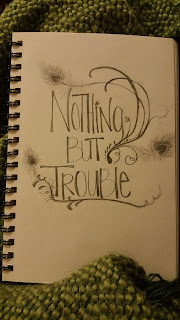****PLEASE NOTE: This is an old post. I no longer post on this blog. For more information, to visit my new blog, or to contact me, visit
HERE****
Greetings, fellow indie authors!
I post resources every so often for first-time indie authors that I hope are helpful to them in their writing process. I love to share what little knowledge I have because I learned most of what I know either from trial and error or someone passing said information on to me. So, spread the wealth, right?
This time around, since I'm in the throes of publishing book two in my new adult series,
Nothing But Trouble, I figured I'd give those of you considering novel publication a brief outline of what goes into publishing--how long it generally takes to get ideas - to paper - to print and the steps I take along the way. Please see my
Author Resources post for links to tools that might come in handy. I haven't updated it in a while, so my apologies, but the bones are there.
How long does it take to write a book?
Well, how much time do you have to write and how series are you about finishing it? For some authors, it only takes 2 months. For me, well, I work a day job and write simultaneously, so it takes me closer to 6 months, and that's writing an average of two days a week. Everyone's process is different. This is mine:
Step One:
Outlining, Brainstorming, and creating a Production Timeline.
The length of time it takes you to do this will vary based on how your mind works and the amount of time you're willing to put into these initial steps. It depends if you're a
plotter or pantser. For me, I'm a little bit of both. It takes a couple weeks to really get my ideas out of my head and organized and I use a variety of techniques to organize my thoughts, including sticky notes for major scenes or themes that need to show up in my story, and then I move them to more cohesive thoughts in
Scrivener. I look up character photos, create storyboards for visual references, do some research on topics I'm unfamiliar with but need to write about and so on. It generally looks something like this:
For a timeline, I generally pick a "release date" and plan backward.
Here's an example:
Step Two: Start writing your first draft! Even if it's just the dedication page or one particular scene you just can't get out of your head. START. You have to get into a groove and the only way to do that is by actually starting. It sounds easy, but trust me, it's not always, especially if you're not already in a writing routine. I generally use National Novel Writing Month (NaNoWriMo) to get the skeleton of my story down, chapter by chapter. I can go in and flesh each chapter out later, but the main scenes are pivotal in getting to know your characters more.
First Draft time Lapse: Depending on length, 1-2 months.
Step Three: When you're finished with your first draft, take a break! This should be at least a couple weeks. I use this time to do some of the following:
- work on marketing
- read for fun
- relax and take a complete step away from book stuff
- start brainstorming new projects
 |
| Notebook for a different project |
Step Four: Go back through, edit and revise, then send your manuscript to beta readers. Provide them questions you want answers to, then give them sufficient time to read, take notes, and really delve into the story so that you get the best feedback possible. While it's out, you'll have 3-4 weeks to work on the following in preparation for publication:
- book cover
- book description
- you can start thinking about promotions
Step Five: After getting the manuscript back from Beta readers, make the edits you want and read through it
again. If you want to, you can even send it to a second group of betas that focus on proofreading and grammar more than content.
Time Lapse: Anywhere from a couple weeks to another month depending on if you send it out again or not.
Step Six: Format. Send it to the editor. While your manuscript is out of your hands yet again, you can start:
- brainstorming or outlining another project
- work on promotional materials
Time Lapse: 1 month
Step Seven: Revise based on editor's feedback and do a
final read-through. This is more of a proofread and essentially your last chance to clean it up and/or make any changes. I would ask someone else to proofread it for you before you publish, to catch the extra spaces, the missing words, etc. that your mind won't notice given its familiarity with the work.
Time Lapse:2-3 weeks
Step Eight: Publish! These steps depend on where you want to sell your book. Here are
some of the platforms to check out:
CreateSpace (paperback)
Amazon (KDP)
Draft2Digital: Kobo, Barnes & Noble, iTunes
Wattpad
Lulu
That's the gist of it! I'm sure there are things I forgot to mention, but this is a great way to get yourself on track to publishing that book you've always wanted to, no matter the drive behind it.
GOOD LUCK!
Linds
xox
p.s. remember, this blog isn't going to be in use after this month, so make sure you
check out my new blog on my website.
Blog





















